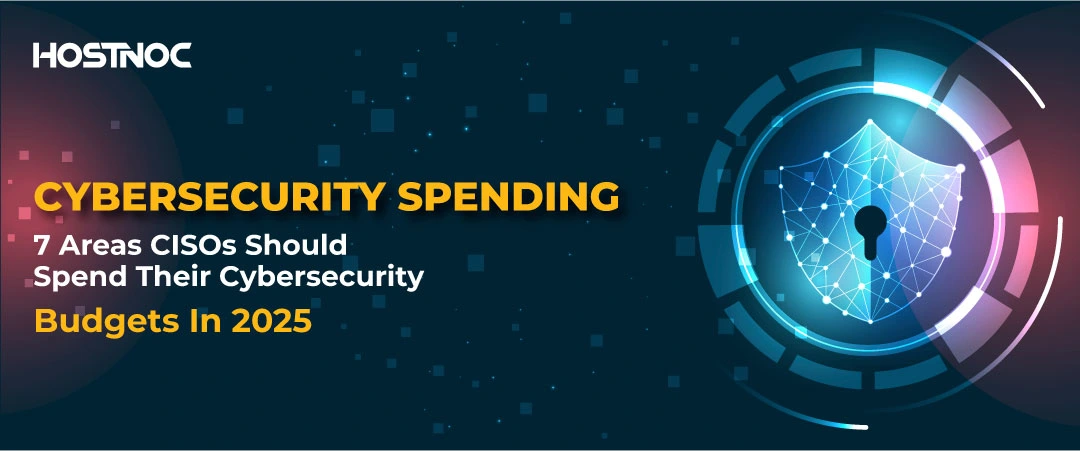Blogs
Cybersecurity Spending: 7 Areas CISOs Should Spend Their Cybersecurity Budgets In 2025
Published by Muhammad Osama November 15, 2024 . 6 min read


7 Technologies That Will Disrupt Businesses In 2025
November 13, 2024
Valheim Server Hosting: A Complete Guide
November 18, 2024Cybersecurity Spending: 7 Areas CISOs Should Spend Their Cybersecurity Budgets In 2025
As we approach 2025, the landscape of cyber threats continues to evolve, necessitating a dynamic and strategic allocation of Cybersecurity Spending budgets. Chief Information Security Officers (CISOs) are under increasing pressure to allocate resources effectively to safeguard their organizations against emerging threats.
This article explores seven key areas where CISOs should focus their cybersecurity spending in 2025.
Cybersecurity Spending: 7 Areas CISOs Should Spend Their Cybersecurity Budgets In 2025
Here are seven areas cybersecurity leaders must spend their cybersecurity budgets in 2025.
Cloud Security
With the rapid adoption of cloud computing, securing cloud environments has become a critical component of any cybersecurity strategy. Cloud security involves protecting data, applications and services hosted on cloud platforms from unauthorized access, data breaches and other cyber threats. As organizations migrate more of their operations to the cloud, investing in robust cloud security measures is essential.
In 2025, cybersecurity leaders should prioritize spending on cloud security tools that provide visibility and control over cloud environments. This includes solutions for identity and access management (IAM), data loss prevention (DLP) and cloud security posture management (CSPM).
Additionally, investing in multi-cloud security strategies that offer consistent protection across different cloud providers will be crucial as organizations increasingly adopt hybrid and multi-cloud environments. By focusing on cloud security, organizations can mitigate risks associated with cloud misconfigurations, data breaches and unauthorized access, ensuring their cloud infrastructure remains secure and compliant.
New Security Technologies
The cybersecurity landscape is constantly evolving, with new threats emerging and old ones becoming more sophisticated. To stay ahead of cyber adversaries, CISOs must invest in cutting-edge security technologies that leverage artificial intelligence (AI), machine learning (ML) and automation. These technologies can enhance threat detection, response and prevention capabilities, enabling organizations to detect and mitigate threats in real time.
In 2025, emerging technologies such as extended detection and response (XDR), zero trust network access (ZTNA) and secure access service edge (SASE) will be vital investments. Extended detection and response provides a unified approach to threat detection and response by integrating data from multiple security products into a single platform, improving visibility and response times.
Zero trust network access and secure access service edge, on the other hand, offer enhanced security for remote and hybrid work environments, ensuring secure access to corporate resources regardless of the user’s location. By investing in these new security technologies, CISOs can enhance their organization’s cybersecurity posture and better protect against sophisticated cyber threats.
Upgrading Existing Security Technology
There is no denying the fact that upgrading to new security technologies is crucial for businesses but upgrading and optimizing existing security infrastructure is equally important if not more. Many organizations rely on legacy systems that may no longer provide adequate protection against modern cyber threats. In 2025, CISOs should allocate part of their cybersecurity budget to upgrading outdated security technologies and infrastructure.
This may involve replacing outdated firewalls, intrusion detection systems (IDS), and intrusion prevention systems (IPS) with next-generation solutions that offer advanced threat protection capabilities. Moreover, CISOs should consider upgrading endpoint security solutions to ensure comprehensive protection against malware, ransomware and other endpoint threats. By investing in upgrades to existing security technologies, organizations can close security gaps, improve operational efficiency and enhance overall cybersecurity resilience.
Security Awareness and Training
Human error remains one of the leading causes of cybersecurity incidents, with phishing attacks and social engineering tactics exploiting employee vulnerabilities. To mitigate these risks, CISOs must invest in security awareness and training programs that educate employees about cybersecurity best practices and the latest threats.
In 2025, organizations should focus on creating engaging and interactive training programs that are tailored to different roles and departments. This includes simulated phishing exercises, interactive e-learning modules and hands-on workshops that teach employees how to recognize and respond to cyber threats.
Additionally, CISOs should consider implementing continuous training programs that reinforce key cybersecurity concepts and keep employees informed about emerging threats. By prioritizing security awareness and training, organizations can create a security-conscious culture and empower employees to act as the first line of defense against cyber threats.
Managed Security Services
Managed security services (MSS) offer a cost-effective solution for organizations looking to enhance their cybersecurity capabilities without the need to build and maintain a large in-house security team. Managed security service providers offer a range of services including threat monitoring, incident response, vulnerability management and compliance management, allowing organizations to leverage expert knowledge and resources.
In 2025, CISOs should consider partnering with managed security services providers to supplement their internal security teams and enhance their cybersecurity posture. By outsourcing certain security functions to a managed service provider, organizations can benefit from continuous monitoring, rapid incident response and access to specialized expertise. This approach not only reduces the burden on internal teams but also provides organizations with the flexibility to scale their security operations based on their needs.
Got server headaches? HostNOC Server Management is your ultimate cure for stress-free IT solutions
Cores
RAM
Storage
Location
Monthly Price
Link
Security
OS Hardening
Anti Threat Software Firewall
Mod_Security Web Protection Module
$74.99 /month
Buy Now
Security
OS Hardening
Anti Threat Software Firewall
Mod_Security Web Protection Module
$99.99 /month
Buy Now
Security Consultants and Integrators
As cybersecurity threats become more complex, organizations may require specialized expertise to address specific challenges or implement new security technologies. Security consultants and integrators can provide valuable guidance and support in designing, implementing and optimizing cybersecurity strategies.
In 2025, CISOs should consider investing in security consultants and integrators to help identify and address gaps in their cybersecurity posture. This may involve conducting security assessments, developing incident response plans or integrating new security technologies into existing infrastructure.
By leveraging the expertise of security consultants and integrators, organizations can ensure their cybersecurity strategies are aligned with best practices and industry standards, reducing the risk of cyber incidents and improving overall security resilience.
Cybersecurity Staff
As the demand for cybersecurity professionals continues to grow, building and retaining a skilled cybersecurity team is crucial for any organization’s success. In 2025, CISOs should prioritize investing in cybersecurity staff to ensure their teams have the skills and expertise needed to address emerging threats and challenges.
Read more: Black Hat 2024: 10 Cybersecurity Tools That Deserve Your Attention
This includes hiring professionals with expertise in areas such as threat intelligence, incident response, cloud security and cybersecurity governance. Additionally, organizations should invest in continuous training and professional development opportunities to help their cybersecurity staff stay current with the latest threats, technologies and best practices.
Read more: 5 Cybersecurity Challenges Of A Hybrid Workplace You Should Be Ready To Face
By investing in cybersecurity talent, organizations can build a robust security team capable of proactively identifying and mitigating cyber threats, ensuring the organization’s security posture remains strong. Where will you spend your cybersecurity budget in 2025? Share it with us in the comments section below.






